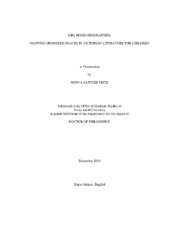| dc.description.abstract | "Girlhood Geographies: Mapping Gendered Spaces in Victorian Literature for Children," analyzes Victorian literature for girls and contemporary discourses on girlhood through the lens of cultural geography in order to examine the importance of place in the Victorian girl's identity work and negotiation of social responsibilities, pressures, and anxieties. The premise of my project is that one of the pressing cultural concerns in Victorian England, which greatly valued the stability of gender and class identities, was to teach children to know their place—not simply their proper position in society but how their position in society dictated the physical spaces in which they belonged and those in which they did not. Girls' virtue, in particular, was evinced in their ability to determine and engage in behavior appropriate to the spaces in which they lived. I argue that, by portraying girls' negotiation of the spaces of the home, outdoors, school, and street, Victorian children's literature sought to organize for the girl reader both the places in which she lived and her ability to define these places in relation to her own subjectivity. Each of my chapters considers a genre or body of children's literature that centers on place, including domestic fiction such as Charlotte Yonge's The Daisy Chain and Catherine Sinclair's Holiday House, literature set in the garden and outdoors, including Christina Rossetti's Speaking Likenesses and Kate Greenaway's Under the Window, and school stories by such writers as L.T. Meade, Geraldine Mockler, and Evelyn Sharp. In analyzing these texts, this dissertation illuminates the manner in which girl characters' relationships with nuanced physical spaces affect their negotiation of personal interests and social responsibilities, and their development into Victorian women. | en |


